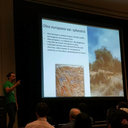
Oussama BadadSouthern Illinois University Carbondale | SIU · Department of Plant, Soils, and Agricultural Systems
Oussama Badad
PhD candidate
About
15
Publications
3,892
Reads
How we measure 'reads'
A 'read' is counted each time someone views a publication summary (such as the title, abstract, and list of authors), clicks on a figure, or views or downloads the full-text. Learn more
325
Citations
Introduction
Currently working on genome wide DNA methylation to study domestication in olive trees using MeDIP-seq. Cis regulatory elements and gene expression. Also working on tilling by capture target sequencing on soybean mutant population .
Publications
Publications (15)
Soybean [Glycine max (L.) Merr.] is the most widely consumed legume crop in the world, providing 56% of the world's oilseed production. To understand genes and gene networks involved in seed composition and plant-pathogen resistance, we used a robust reverse genetics technology to study the role of a wide range of genes. Tilling-by-Sequencing + (Tb...
Verbascum thapsus is a biennial plant native to Europe, northern Africa, and Asia and introduced in the Americas and Australia. We present the whole genome sequence of this species. Illumina paired-end reads were assembled by a de novo method followed by a finishing step. The raw and assembled data are publicly available via GenBank: Sequence Read...
Soybean [Glycine max (L.) Merr.] is a complete and a major source of plant protein with several health benefits for humans and animals. The protein ingredients market is driven by several factors including protein functionalities, healthy diet, nutritional value, and healthcare products. The availability of high protein soybean varieties is importa...
Key message
Soybean acyl-ACP thioesterase gene family have been characterized; GmFATA1A mutants were discovered to confer high oleic acid, while GmFATB mutants presented low palmitic and high oleic acid seed content.
Abstract
Soybean oil stability and quality are primarily determined by the relative proportions of saturated versus unsaturated fatt...
Argania spinosa plays an important socioeconomic and ecologic role in different contrast situations like the arid zone located in the midwestern Morocco. This tree is used as a food and feed and as a resource for both pharmaceutical and cosmetic compounds. In the last decades, this genetic resource has faced significant threats from climate change,...
Secondary metabolites are particularly important to humans due to their pharmaceutical properties. Moreover, secondary metabolites are key compounds in climate change adaptation in long-living trees. Recently, it has been described that the domestication of Olea subspecies had no major selection signature on coding variants and was mainly related t...
Soybean is the second largest source of oil worldwide. Developing soybean varieties with high levels of oleic acid is a primary goal of the soybean breeders and industry. Edible oils containing high level of oleic acid and low level of linoleic acid are considered with higher oxidative stability and can be used as a natural antioxidant in food stab...
Reverse genetic approaches have been widely applied to study gene function in crop species; however, these techniques, including gel-based TILLING, present low efficiency to characterize genes in soybeans due to genome complexity, gene duplication, and the presence of multiple gene family members that share high homology in their DNA sequence. Chem...
Platelets, as nonnucleated blood components, are classically recognized for their pivotal role in hemostasis. In recent years, however, accumulating evidence points to a nonhemostatic role for platelets, as active participants in the inflammatory and immune responses to microbial organisms in infectious diseases. This stems from the ability of acti...
Soybean is a major source of protein and is the second largest source of oil worldwide. Developing soybean lines with high levels of stearic acid is a primary goal of the soybean industry. Unlike other polyunsaturated fatty acids, the saturated stearic acid is desirable for nutrition because it does not exhibit cholesterolemic effects on human heal...
Background: The Argane tree ( Argania spinosa L. Skeels) is an endemic tree of mid-western Morocco that plays an important socioeconomic and ecologic role for a dense human population in an arid zone. Several studies confirmed the importance of this species as a food and feed source and as a resource for both pharmaceutical and cosmetic compounds....
Background: The latest studies have shown the effectiveness of Chloroquine against Coronavirus. However, since the tolerance and effectiveness of statistical data must be taken into account before proposing treatment to a patient, these promising results are often lacking.
Since the CYP2C8, CYP2D6 and CYP3A Absorption, Distribution, Metabolism and...
Soybean is an attractive crop for the bio-industry due to being a relatively cheap raw material. The content of the eighteen-carbon chain fatty acids like saturated stearic acid and unsaturated fatty acids such as oleic acid and linoleic acid represent ~3%, ~20%, and ~55% in soybean seed oil. These fatty acids are precursors for many bioactive fatt...
Significance
We sequenced the genome and transcriptomes of the wild olive (oleaster). More than 50,000 genes were predicted, and evidence was found for two relatively recent whole-genome duplication events, dated at approximately 28 and 59 Mya. Whole-genome sequencing, as well as gene expression studies, provide further insights into the evolution...
This is a summary of the activities and scientific content of the first International Society for Computational Biology Student Council symposium in Africa. This meeting organized by the students for the students took place 8th of March 2015 in Dar Es Salaam, Tanzania.













































